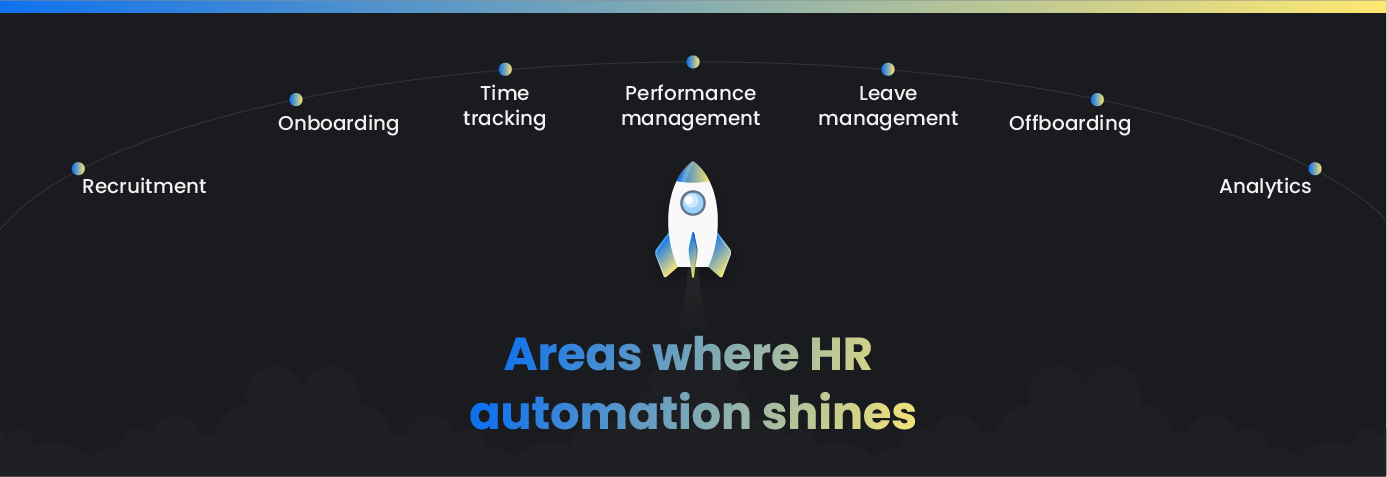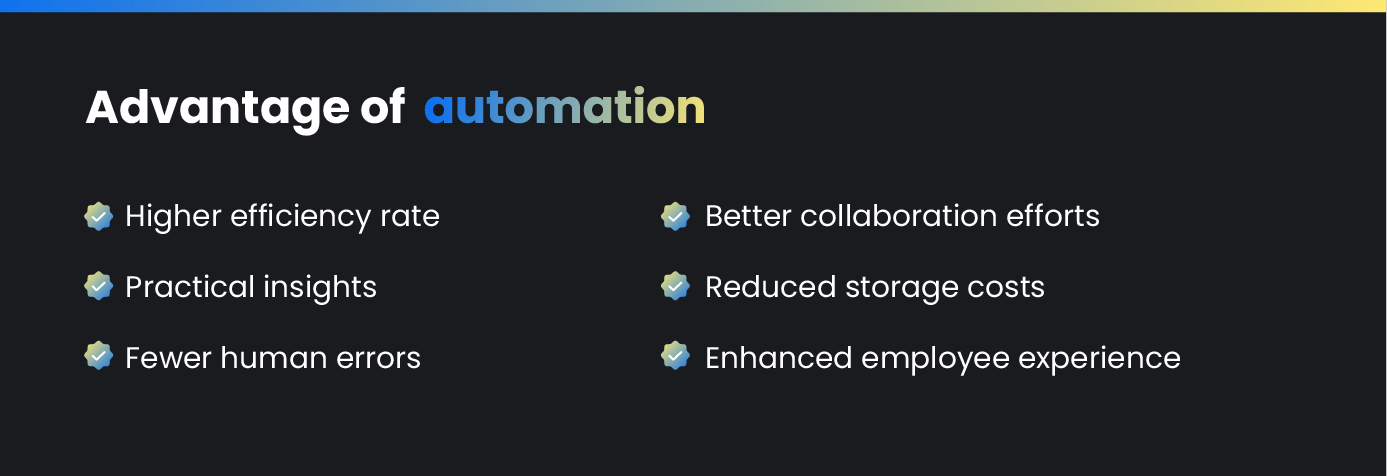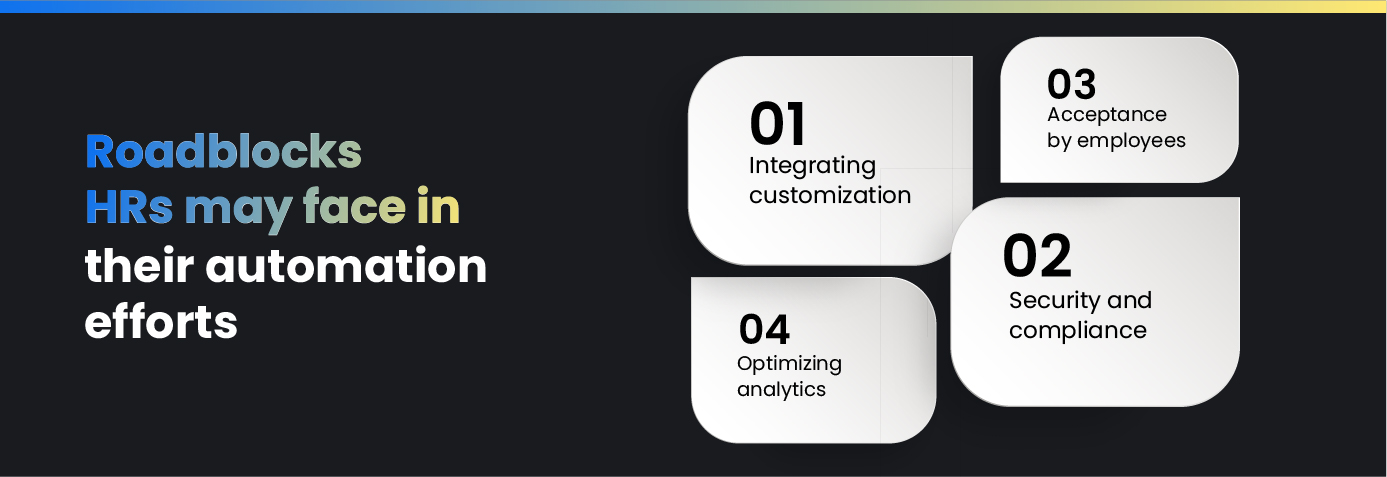The workplace continues to evolve, even after the brunt of the pandemic is over. This has compelled the HR department to quickly adapt for efficiency and effectiveness. The HR department is now proactively exploring technologies for HR process automation.
In this article, we will be discussing why the transition happened and the three core aspects of HR process automation — onboarding, engagement, and HRSD (human resource service delivery) — in detail.
What is HR process automation?
Human resource process automation involves utilizing artificial intelligence or other technologies to streamline and automate repetitive tasks of the HR department. The goal of HR process automation is to reduce redundant tasks and aid the HR team in becoming more efficient.
What makes HR process automation work?
HR process automation provides insights across all processes, analyzes them in real-time, and allows HR leaders to make quick decisions. The HR automation tool also helps the HR department deep dive into employee data for analyzing organizational sentiment and narrowing down opportunities to improve the employee experience.
However, it is important to look at the processes together instead of in silos. Businesses need to analyze their HR processes constantly, and benchmark how they can work together to achieve organizational goals.
Areas where HR automation shines

Recruitment
With automation, routine tasks can be minimized in the recruitment process. This includes (but is not limited to) screening high volumes of applications to help HRs engage with the candidate throughout the process. helps recruiters directly focus on selecting the right candidates where human judgment is essential.
Onboarding
Automated workflows can cut the processing time of onboarding formalities from days to just a few hours. For example, there’s no need for you to manually perform tasks like sending out introductory emails, collecting identification proof from the new hires, setting up new accounts, and assigning an onboarding buddy.
Time-tracking
Contractors are now regulars on a company’s roster. Therefore, time tracking becomes essential for them, which in turn adds to the complexity of HR functions. HR service automation tools help check time logs and get streamlined reports that can significantly simplify payroll processes.
This also helps boost employee experience as the need to manually log time is eliminated from the process. Automation also helps in building trust between employees and the overall organization.
Performance management
The task of evaluating the KPIs of employees in a growing company can be cumbersome. There is always a scope for error when calculating the performance of employees manually. Implementing effective HR automation workflows can make the process of performance management more comprehensive. With real-time tracking and insightful reports, managers can directly share results with their team members and help each employee with an action plan to improve their performance. This also helps in acknowledging their efforts promptly to keep them motivated.
Leave management
It is always tedious to manually input every employee’s attendance and approve leaves. It is an important process to follow since it influences payroll calculation. Automating this process can save significant man-hours annually. An HR automation system for leave management helps employees get quicker leave approvals and update their attendance in real-time.
Offboarding
The exit process can be tough on an employee and the organization. Employing HR automation systems help HR teams complete paperwork on time and initiate the process of knowledge transfer or collecting company assets.
Analytics
HR teams handle a considerable amount of employee data regularly. This means that as your company grows, you will have to expand your HR department to handle menial tasks and maintain the data. that can easily be automated.
Not only does analytics make it easier for you to streamline and manage operations for legal purposes, but it also helps employees by providing them with essential information about their performance. Based on analytics and reporting, HR teams can then contribute effectively towards improving organizational processes.
Advantages of HR automation

Here are some of the top benefits businesses can leverage by introducing HR process automation into their business:
1. Higher efficiency
A major chunk of an HR’s responsibility is staying on top of formalities and paperwork. This not only opens room for human errors but can be extremely time-consuming. It also reduces productivity as the team ends up focussing on repetitive tasks.
HR workflow automation helps save man-hours and increase efficiency owing to standardized procedures and fewer errors. More importantly, it can open up an HR’s schedule and let them focus on strategic decision-making.
2. Practical insights
With the right HR process automation, you can track, manage, and scrutinize all kinds of employee data across the company. This ensures profitability and better overall performance. You can also use insights from analytics to improve processes that are counterproductive and understand the overall sentiment around them.
3. Fewer human errors
Handling payroll, managing timesheets, and tracking leaves can be seamlessly managed by HR automation and could be much less prone to errors.
4. Better collaboration efforts
HR automation provides a bird’s eye view of specific tasks and processes involved with any given project. When people have a clear idea of their tasks and their teammates’ responsibilities, communication improves immensely. It also helps them accomplish more as the entire team works efficiently.
5. Reduced storage costs
In today’s digitized age, records can be kept electronically. HR automation software allows you to keep one central place for e-documents and electronic storage of the files that are a part of your organization. It can help you save space and reduce costs by combining digital information storage with a searchable database.
6. Enhanced employee experience
When HR staff are inundated with all of their day-to-day tasks, it’s easier to forget about new candidates and lose them in the chaos. This creates an unfavorable candidate experience regardless of their hiring status. Automating certain HR tasks helps HR teams to get back on track with new candidates and improve standardized processes.
Furthermore, current employees can profit from self-service workflows. For example, reimbursement requests can be quickly approved and processed faster due to automated systems.
What roadblocks HRs may face in their automation efforts?

While implementing HR workflow automation, these are some challenges that the entire organization may face. Here are some of the most common challenges that organizations may encounter:
Integrating customization
Every organization is different. Not every tool will meet the company’s needs on every point. So finding the right customization in your HR automation software is tricky, albeit important.
Security and compliance
Your HR automation software must be equipped with strong security measures to protect company data and prevent any third-party intervention or malware breach. The automation system must also seamlessly synchronize with regulatory requirements.
Acceptance by employees
Your employees might find it tricky to work with the new HR automation system during the initial days. But there is a narrow window where they have to acclimatize with the new employee software. To make the adoption of HR automation easier for employees, businesses must make a significant investment in training and development sessions.
Optimizing analytics
HR departments generate and handle a mammoth amount of data. Manual analysis of all the data is an arduous task. That is why HR analytics should be an integral part of the HR automation process. But without the right team to understand the data, even the most advanced HR tool will not be of much help.
Summing up
Implementing the best practices is important to make sure that automated workflows run smoothly and employees’ concerns are addressed quickly. Organizations that are looking for HR process automation should keep these key aspects in mind and identify the areas where automation can be helpful.
The implementation of any new HR technology should not be taken lightly, as a poorly executed process will not achieve the desired results and instead worsen the process further. To learn about how Leena AI can help you meet your HR automation goals, schedule a call with our experts.






